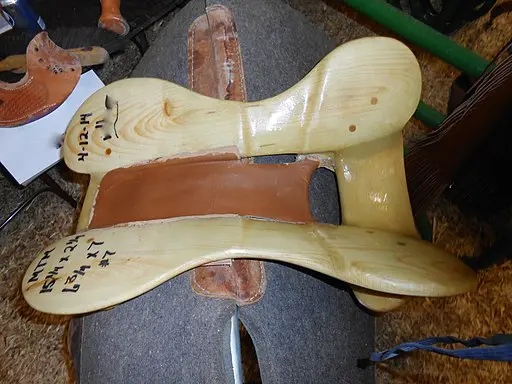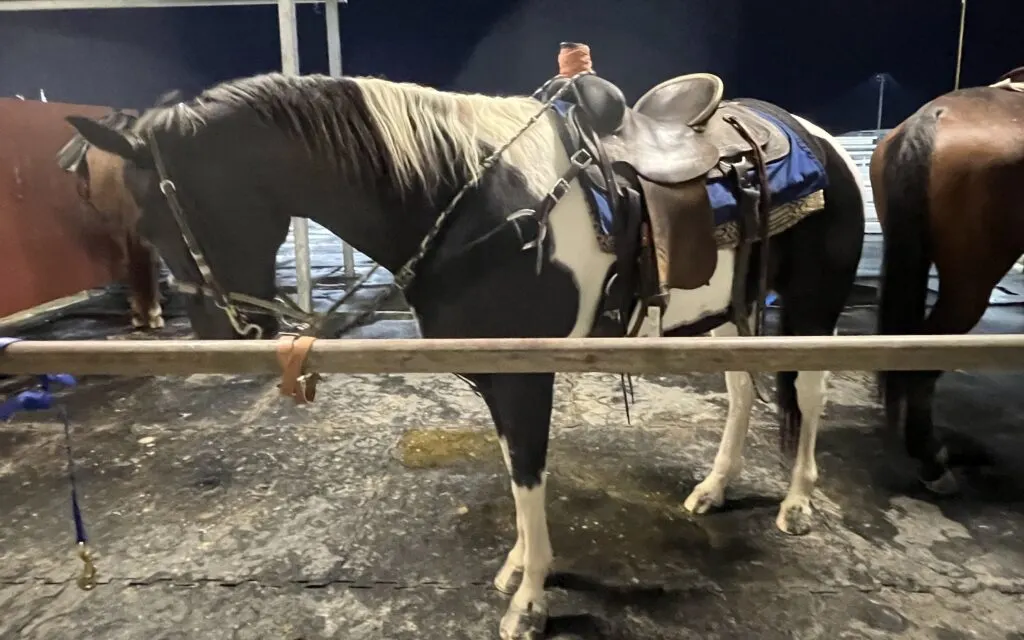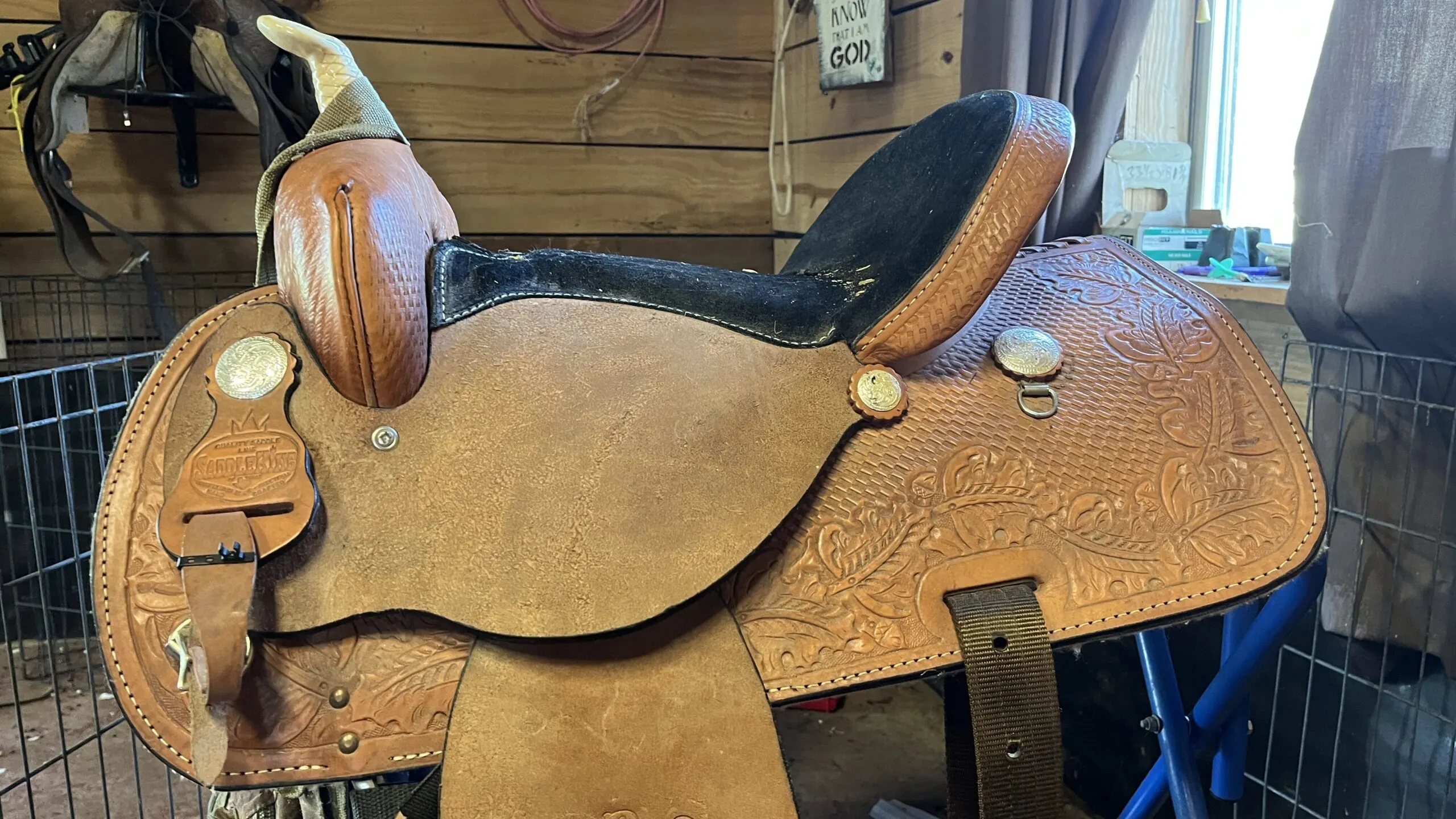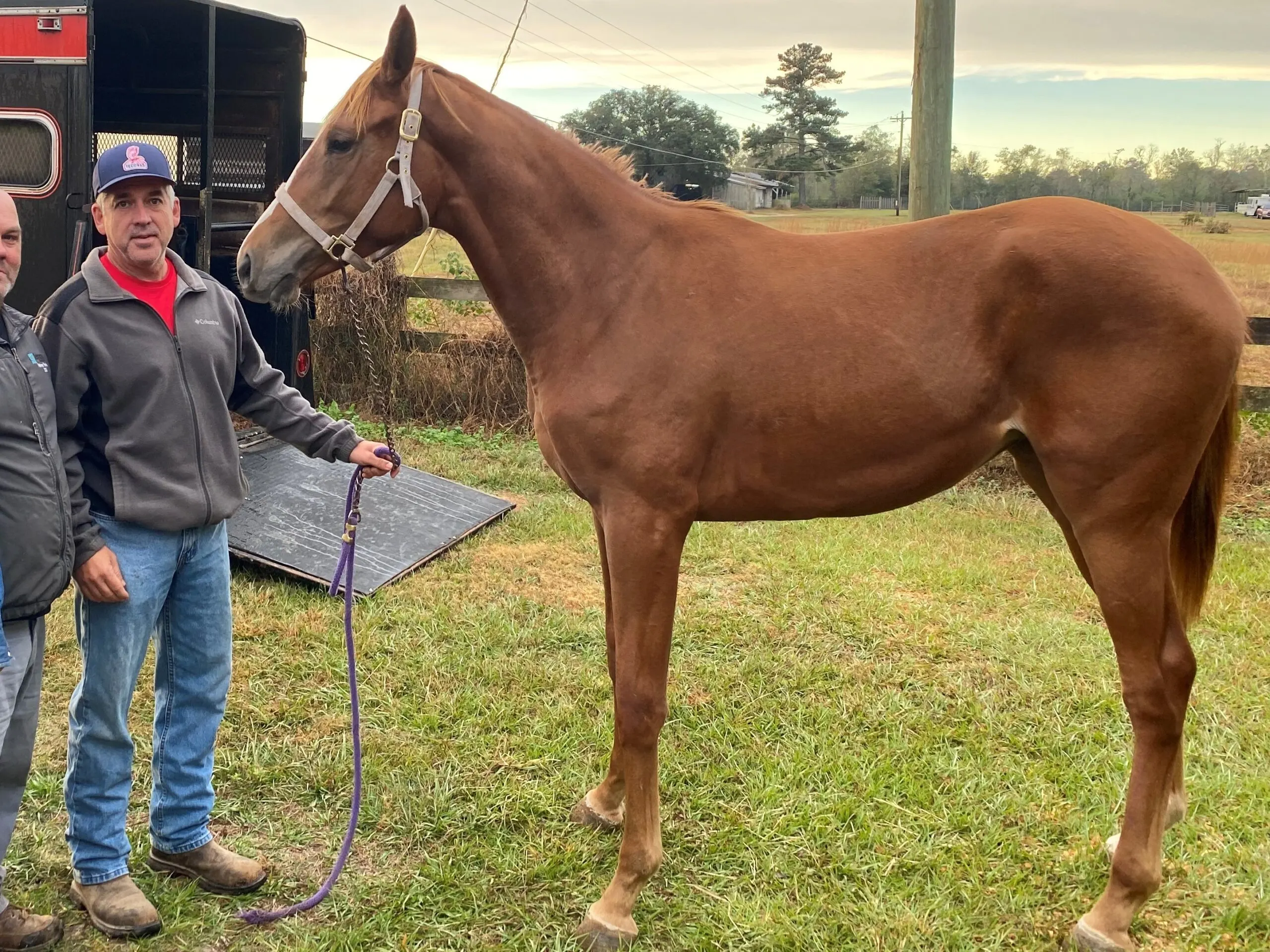Last updated: September 7, 2023
Any links on this page that lead to products on Amazon are affiliate links and I earn a commission if you make a purchase. Thanks in advance – I really appreciate it!
While checking my Western horse saddle, I noticed the latigo was splitting. When I asked a nearby boy to grab me a replacement, his puzzled look said it all: not everyone knows the parts of a saddle. And if you’re a rider or aspiring to be one, it’s crucial you do.
A Western horse saddle isn’t just about style or cultural value; it’s a combination of several components like the tree, horn, stirrups, and cinch. When cared for, a high-quality saddle can last a lifetime.
In this guide, we’ll delve into the essential parts of a Western saddle, ensuring you understand its anatomy, lifespan, and maintenance tips.

The Anatomy of a Saddle: A Broad Overview
At first glance, all saddles might seem the same. But there’s more than meets the eye. Western saddles are like the Swiss Army knives of the saddle world — they’re made for various tasks, from roping cattle to leisurely trail rides.
Other saddles, like the English ones, are more streamlined and often used for specific activities like jumping or dressage. The main difference? Western saddles have a horn in front, which is super useful when roping. English saddles? No horn. They have a flatter seat, giving riders more freedom to move, especially during jumps.
Why Each Part Matters
Imagine riding a bike. If your seat’s too hard or the handles are loose, it’s uncomfortable, right? The same goes for horse saddles. Each part has a purpose:
- The seat keeps the rider comfy.
- The horn on Western saddles gives something to hold onto, especially when working on a ranch.
- Stirrups let riders rest their feet and help with balancing.
- The tree (the saddle’s backbone) ensures the horse’s comfort and evenly spreads the rider’s weight.
If even one part isn’t right, both the rider and the horse can end up feeling uncomfortable or even get hurt. That’s why understanding your saddle’s anatomy is so essential. It’s all about ensuring a safe and pleasant ride for both you and your horse.


Parts of a Western Saddle
To learn the parts of a saddle, it helps to view it in three primary sections: the top, sides, and the straps that keep it secure on the horse. Understanding each section can give you a clearer picture of the saddle’s layout and the purpose of each part. Let’s break down the saddle piece by piece so you know what each part does:
- Tree: Think of this as the saddle’s foundation, typically made of wood. The tree spreads the rider’s weight evenly, impacting comfort, balance, and the amount of pressure on the horse’s back. Western saddles have larger tree surfaces than English ones, ensuring better weight distribution with minimal padding.
- Pommel: Situated at the saddle’s front, the pommel is crucial for rider stability and comfort. It prevents too much pressure on the horse’s spine and offers a grip point for the rider.
- Gullet: This V-shaped space beneath the pommel ensures the saddle sits snugly on the horse while avoiding undue pressure on the withers.
- Seat: This is the rider’s spot, designed wider than the pommel for comfort. Western saddle seats are deep and often cushioned with foam for an extra plush feel.
- Cantle: This raised back part of the saddle provides support and stability. Western saddles often have a noticeably high cantle, giving riders enhanced support.
- Skirt: Positioned below the tree, the skirt is a blend of leather and natural sheepskin. It safeguards the horse from the tree’s hard sections. Also, “D-rings” on the skirt are there to connect to the breastplate.
- Fenders: These broad leather sections connect the saddle tree at the top and house the stirrups at the bottom. Fenders shield the rider’s legs from direct contact with the horse, ensuring comfort for both parties.
- Stirrups: Attached beneath the fenders, these robust frames support the rider’s feet. They help mount the horse, provide a resting point for the feet, and assist with balance during rides.
- Strings: These leather strips on the saddle’s sides were traditionally used to tie objects to the saddle. While less functional today, they add a touch of classic Western aesthetics to the saddle.
- Cinch: This broad strap, typically crafted from leather, wraps behind the horse’s forelegs, acting as the primary anchor, keeping the saddle in place. Depending on the saddle’s design, there might be just a front cinch (referred to as single rigging) or both front and back cinches (known as double rigging).
- Latigoes: Essentially, these are leather straps found on both sides of the saddle. The top end of a latigo connects to the saddle’s “D-ring,” while the bottom end latches onto the cinch using a “cinch ring.” It’s important to note that only the left latigo is usually manipulated when fastening or unfastening the saddle. The offside latigo can be referred to as a billet, with both terms often used interchangeably.

The Importance of Proper Fitting
Choosing a saddle isn’t just about picking the prettiest or the most affordable one. Just like you wouldn’t wear shoes that are too big or too small, the right saddle fit is crucial. Here’s why:
Ensuring Comfort and Safety: A saddle that fits well is like a snug, comforting hug for both the rider and the horse. For the horse, a proper fit means no unnecessary pressure points, which can cause discomfort or even injury. For the rider, a well-fitting saddle provides the needed stability, ensuring they won’t slip or lose balance while riding.
Dangers of the Wrong Fit:
- For the Horse: An ill-fitting saddle can cause sores or bruises. Over time, this can lead to behavioral issues as the horse starts associating riding with pain. In worst-case scenarios, a poor fit can even damage the horse’s spine or muscles.
- For the Rider: If the saddle doesn’t fit the rider well, it can lead to an unstable seat. This increases the chances of falling off, especially during fast rides or sudden stops. Additionally, an ill-fitting saddle can lead to backaches or discomfort during longer rides.
In short, a saddle isn’t a one-size-fits-all item. Just as every horse and rider is unique, finding the right saddle fit is crucial for a safe, enjoyable, and comfortable riding experience. So, always prioritize proper fitting when picking out or adjusting your saddle.
Below is a helpful YouTube video showing how to clean and condition a western saddle.
Saddle Maintenance and Lifespan
Just like any cherished possession, your Western saddle requires regular care to ensure its longevity. Dive into the essentials of saddle maintenance and discover how to prolong its life for years of comfortable rides.
- The Necessity of Routine Care: Regular cleaning and maintenance can not only enhance the saddle’s appearance but can also prolong its lifespan and ensure it remains safe for both the rider and the horse.
- Predicting Your Saddle’s Lifespan: Various factors influence how long a saddle will last, from the quality of the materials to the frequency of use. Understanding these can help riders set realistic expectations about their saddle’s durability.
- Red Flags and Replacement Indicators: Recognizing the signs that your saddle might need mending or replacing is crucial. Staying vigilant can prevent accidents and ensure continuous comfort for both rider and horse.
What Parts of a Saddle Can be Replaced?
When one of my saddles gets damaged, I have to either repair it or buy a new saddle. Of course, replacing a single part from a Western horse saddle seems more appealing than buying a new one, but it’s not always the most cost-effective strategy.
The pommel, seats, fenders, stirrup leathers (straps that hold the stirrups), paddings, cinches, latigoes, and a few other saddle parts can be replaced or repaired depending on the damage. However, the cost is usually so high that it’s not worth replacing the parts and getting back your old saddle when you can probably get a new saddle at the same price.
Other parts, like the gullet or the tree, can’t be replaced and require you to buy a new one. Unless you have a Western horse saddle with an interchangeable gullet, you’d have to replace the whole saddle if the gullet is too tight.
If the gullet is extra wide, you can try using saddle pads, but that might make riding the horse uncomfortable. The tree of the saddle should also be intact. You can check if the tree is broken by laying the saddle on a flat surface and exerting gentle pressure on the seat.
If you hear popping sounds, the tree is most likely broken. You can replace it, but it’s expensive work, so buying a new saddle is best. We’re lucky to have a good saddle repairman near us who charges reasonable rates. But he is so backed up with work that it takes at least six months to return your saddle.
My advice on replacing or repairing a saddle would be to weigh your options by consulting a professional, assessing the damage and replacement costs, and looking into new saddles’ rates.
Common Mistakes to Avoid
Navigating the world of saddlery can be intricate, and even seasoned riders can make missteps. Here, we’ll highlight common mistakes to avoid for a safer, more comfortable ride.
- Underestimating the Saddle Pad: Many riders fail to recognize the significance of a good saddle pad. It doesn’t just provide cushioning; it also helps in distributing the rider’s weight and protecting the horse’s back. Skipping or using a worn-out pad can lead to discomfort or even injury for the horse.
- Neglecting Regular Fit Assessments: Just as our bodies change over time, so do the shapes of our horses. It’s crucial to periodically check and adjust the saddle’s fit to ensure that it remains snug and comfortable. A poor fit can lead to pain and soreness for both the rider and the horse.
- Disregarding Signs of Wear: Saddles, like all equipment, undergo wear and tear. Ignoring early signs, such as minor cracks or loosening stitches, can result in bigger problems down the line. It’s essential to address these issues promptly to extend the saddle’s lifespan and ensure safety.

How Long Do Western Saddles Last?
Getting the right fit for your horse’s saddle is one thing, but successfully predicting how long the saddle will last is another. There is no hard and fast rule for how long a Western horse saddle lasts; a lot depends on how well you care for it.
A high-quality Western horse saddle can easily last 25 years, but you’ll be lucky to get five good years from a cheap saddle. Saddles will start to show signs of aging and can be uncomfortable for horses relatively quickly when you don’t take care of them.
Western horse saddles come in dozens of different materials and configurations, and each has unique durability. Plus, if you have a young horse, an aging horse, or a horse gaining or losing weight, you will likely need to change its saddle more frequently.
The saddle is the most important riding tack for a horse. It would be best if you kept an eye on your horse’s behavior when you suspect the saddle no longer fits. If you notice any unusual behavior, you should probably get the saddle checked by an experienced saddle fitter.
If you’re competing, riding a lot, and expecting the best performance from your horse, you should change saddles every two years because the padding and texture deteriorate, and the saddle fit won’t be ideal. Always use a correctly fitting saddle pad when using a western saddle.
However, I typically get much more time from my pleasure riding saddles compared to competition saddles.

Tips to Extend the Life of Your Western Horse Saddle.
- Wipe the saddle down, and give it a good cleaning with saddle soap.
- Apply leather conditioner for additional protection
- Let the leather dry naturally.
- Store your saddle in a cool, dry area on a saddle rack. If you keep your saddle in a dusty place like most barns, then cover it with a sheet or saddle cover.
Conclusion
Navigating the intricacies of Western saddles can be daunting, but it’s an enriching journey worth undertaking. From understanding the parts of a saddle, like a tree’s foundational role and the security provided by the pommel, to the comfort offered by the seat, each component plays a pivotal role in ensuring a safe and enjoyable ride.
Equally important is the commitment to saddle maintenance. A well-cared-for saddle not only stands the test of time but also ensures the safety and comfort of both horse and rider. It’s an investment in the well-being of your equine companion and in the quality of your riding experience.
So, as you move forward, remember the value of a good saddle and the importance of regular maintenance. By doing so, you’ll not only enhance your riding experience but also ensure the well-being of your trusted steed. Happy riding!
FAQ
Are Western saddles safer than English horse riding saddles?
Western saddles are safer for beginner riders because they are bigger and easier for riders to keep their balance than an English saddle. Plus, the Western saddle’s horn gives a novice rider something to hold on to.
How much do Western saddles weigh?
Most Western saddles weigh about twenty-five pounds, but they vary greatly depending on the material used to make them and their design features. Some saddles with lots of metal decorations can weigh well over forty pounds.
Meet Miles Henry
An avid equestrian and seasoned racehorse owner, Miles Henry brings his extensive experience to the equine world, proudly associating with the AQHA, The Jockey Club, and various other equine organizations. Beyond the racetrack, Miles is an accomplished author, having published various books about horses, and is a recognized authority in the field, with his work cited in multiple publications.
🔗 Connect with Miles:
Twitter
Facebook
YouTube: Check out race highlights, horse care tips, and more!

